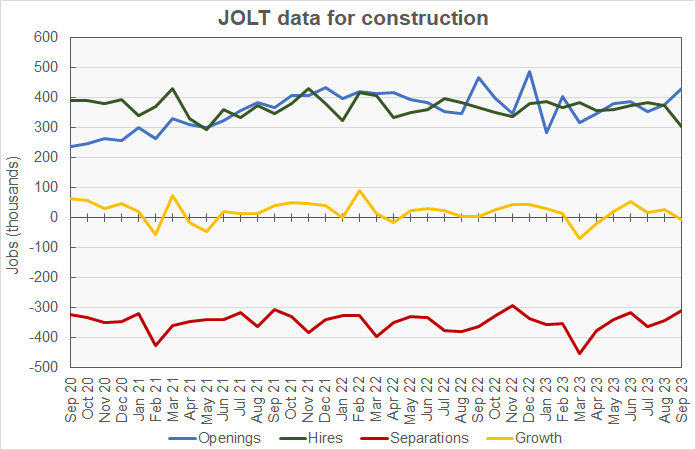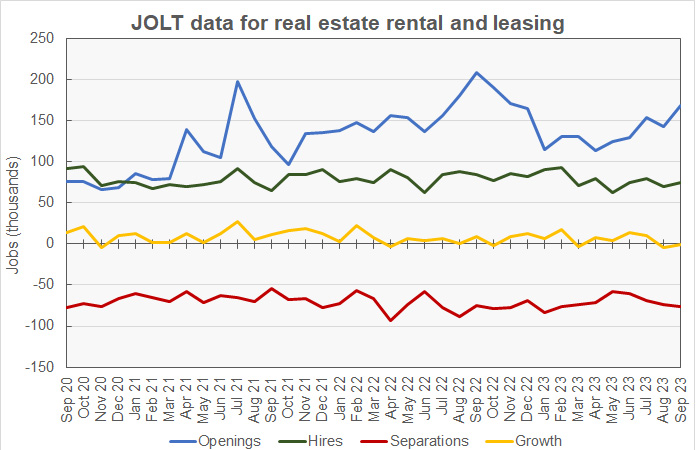The Job Openings and Labor Turnover (JOLT) report from the Bureau of Labor Statistics (BLS) said that the number of job openings in September was 9.55 million. This was reported to be up 55,000 openings month-over-month, but only because the openings figure for August was revised lower by 113,000 openings. Job openings were down 1,310,000 openings from the year-ago level.
Hiring was up from last month’s revised (-7,000) figure for the economy as a whole, rising 21,000 to a level of 5.87 million hires. Total separations fell 157,000 from last month’s revised (+11,000) figure to a level of 5.53 million. Within total separations, quits were reported to be nearly unchanged while layoffs fell 9.8 percent. Quits represented 66.2 percent of total separations for the month. A high number of people quitting their jobs generally means that people feel that jobs are readily available and that they can find better employment elsewhere.
Overall employment higher
For a discussion of the JOLT report and how it relates to the Employment Situation Report, please see the paragraph at the end of this article.
The September job openings figure represents 5.7 percent of total employment plus job openings. For comparison, the unemployment rate in September was reported to be 3.8 percent and 6.36 million people were unemployed. Another 5.37 million people said that they would like a job but were not counted as being in the labor force since they were not actively seeking employment.
The excess of hiring over separations in the September JOLT report implies an employment increase of 341,000 jobs for the month. Last month’s employment increase was revised to 163,000 jobs, down by 21,000 jobs from the gain reported last month.
Of those leaving their jobs in September, 3.66 million quit voluntarily, while 1.52 million people were involuntarily separated from their jobs. The remainder of people leaving their jobs left for other reasons, such as retirements or transfers. The portion of people quitting their jobs was unchanged from last month’s figure at 2.3 percent of the labor force. The involuntary separations rate was down slightly from last month’s revised figure at 1.0 percent.
Construction openings jump while hiring falls
The first chart, below, shows the employment situation for the construction jobs market over the last 37 months. It shows that September saw a net loss of 7,000 construction jobs compared to last month’s gain of 28,000 jobs.

Construction jobs openings in September were reported to be 431,000 jobs, 7.5 percent lower than the year-earlier level. On a month-over-month basis, openings for construction jobs were reported to rise by 56,000 openings from August’s revised (+25,000) job openings figure. Job openings in the construction category represent 5.1 percent of total employment plus job openings, up from the 4.2 percent level reported last month.
Hiring was reported to be down 69,000 jobs in September from the prior month’s revised (+16,000) jobs figure at 303,000 new hires. The number of construction jobs that were filled in September was reported to be down 17.2 percent year-over-year.
Construction jobs total separations were reported to fall by 34,000 jobs from the prior month’s revised (+7,000) figure to 310,000 jobs. Quits were reported to fall by 16,000 jobs from August’s revised (-8,000) figure to a level of 143,000 jobs.
Layoffs were reported to fall by 25,000 from August’s revised (+16,000) figure to 150,000 jobs. “Other separations” which includes retirements and transfers, were reported to be up 6,000 at 16,000 jobs. Quits represented 46 percent of separations for the month, down by 4 percentage point from the level reported last month.
RERL job openings and hiring higher
The last chart, below, shows the employment situation for the real estate and rental and leasing (RERL) jobs category. Employment in this jobs category was reported to fall by 1,000 jobs in September.

The number of job openings in the RERL category was reported to be 168,000 jobs at the end of September. This was up 26,000 job openings from the revised (-4,000) level of the month before. Job openings in September were 40 percent lower than the unusually high year-earlier level. Job openings in the RERL category represent 6.5 percent of total employment plus job openings.
Hiring in September was up by 5,000 jobs from August’s revised (+1,000) level at 75,000 jobs. The hiring figure was 10.7 percent below the year-earlier level.
Total separations in the RERL jobs category in September were up by 2,000 from August’s revised (-3,000) figure at 76,000 jobs. Quits were down by 6,000 from August’s unchanged figure at 41,000 jobs. Quits represented 54 percent of total separations in September, down from the revised level of 61 percent reported in August. Quits had been 80 percent of total separations last June. Layoffs were reported to rise by 9,000 from August’s figure to 30,000 jobs.
The numbers given in the JOLT report are seasonally adjusted and are subject to revision. It is common for adjustments to be made in subsequent reports, particularly to the data for the most recent month. The full current JOLT report can be found here.
Comparing the reports
The US labor market is very dynamic with many people changing jobs in any given month. The JOLT report documents this dynamism by providing details about job openings, hiring and separations. However, it does not break down the jobs market into as fine categories as does the Employment Situation Report, which provides data on total employment and unemployment. For example, while the Employment Situation Report separates residential construction from other construction employment, the JOLT report does not. The Employment Situation Report separates residential property managers from other types of real estate and rental and leasing professionals, but the JOLT report does not. However, the JOLT report provides a look at what is driving the employment gains (or losses) in broad employment categories.













